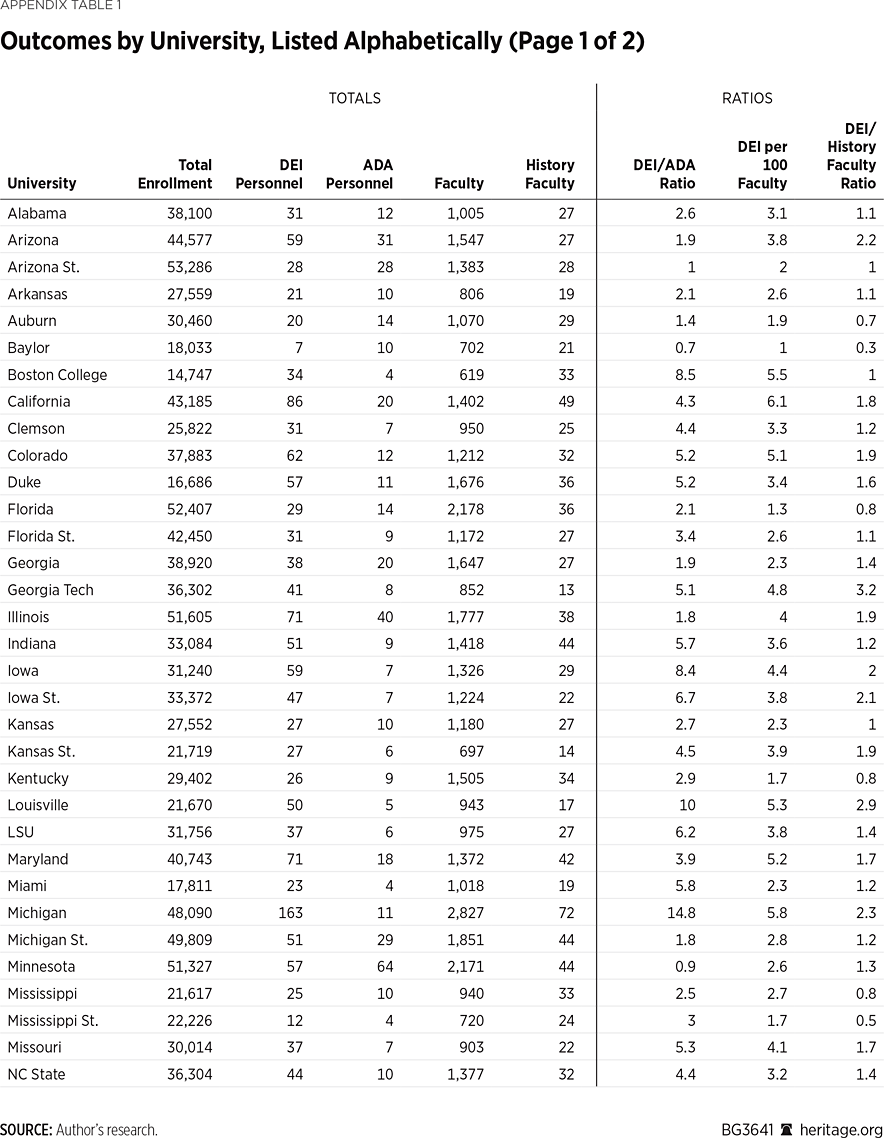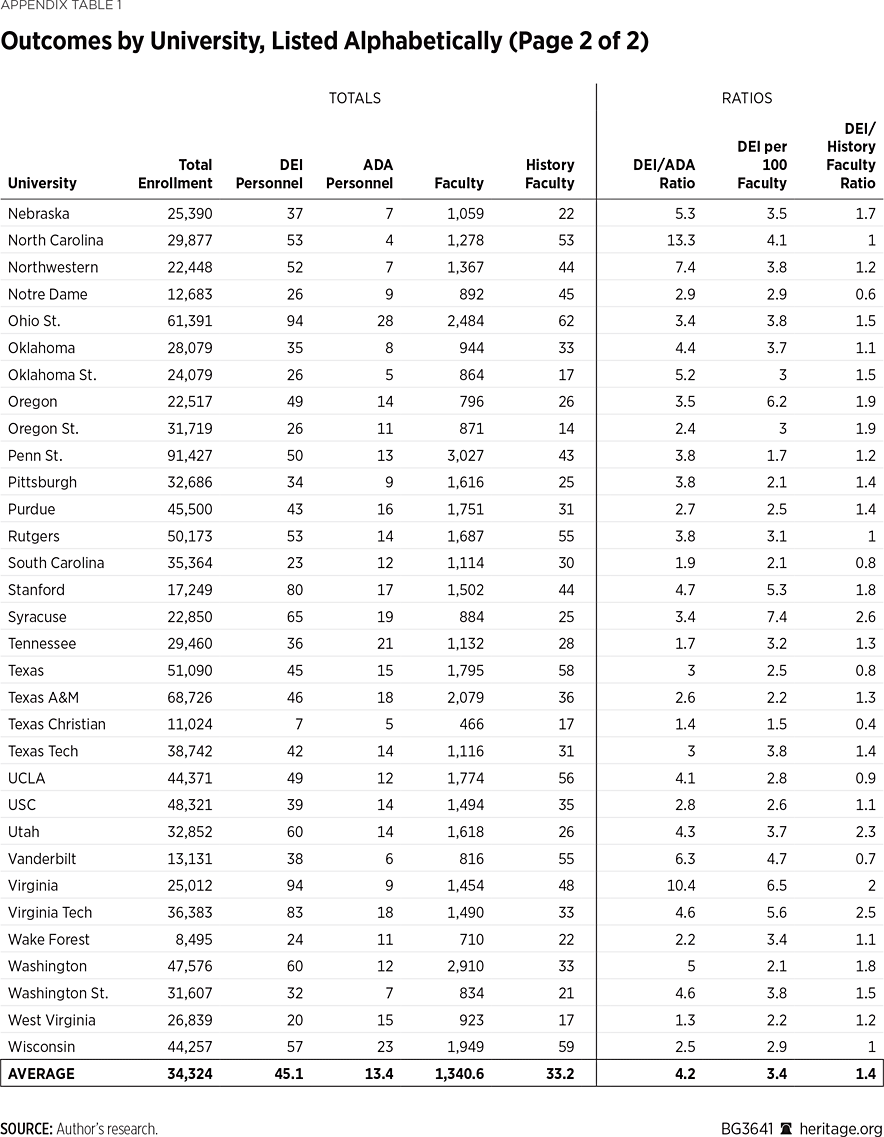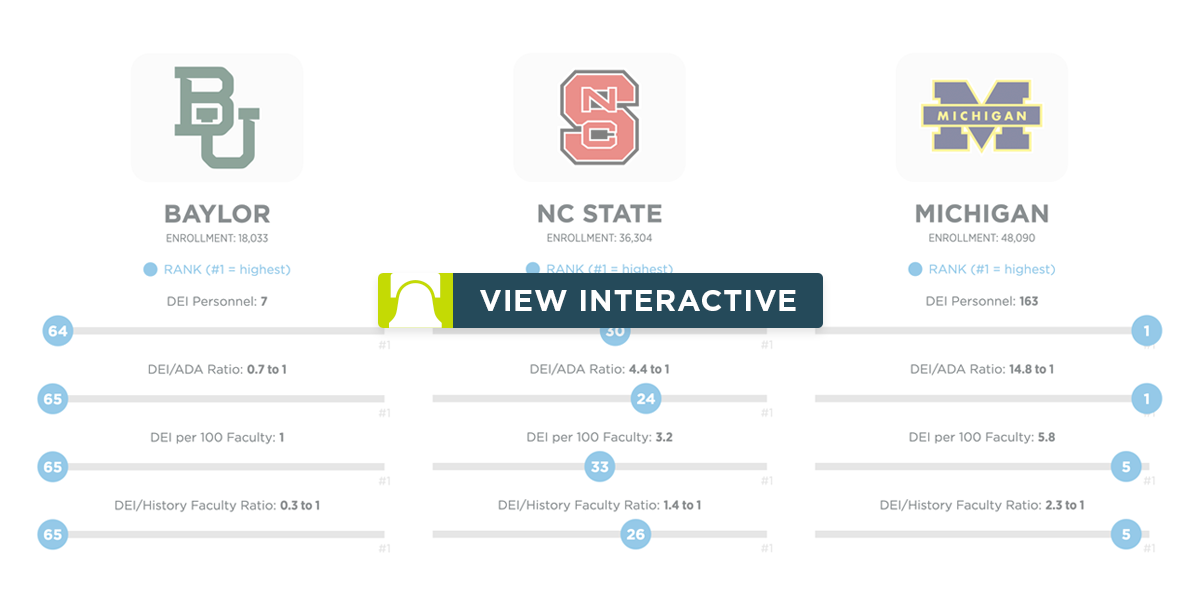The promotion of diversity, equity, and inclusion (DEI) on college campuses has become a central concern of higher education. Universities have created administrative and staff positions tasked with developing programming and offering services related to DEI. While it is widely understood that universities have devoted significant resources and attention to DEI goals, there has been little systematic examination of the scope of DEI staffing in the academy. Similarly, it is unclear how DEI staffing varies across institutions and how levels of DEI personnel compare to other staffing priorities.
University DEI Staffing
This Backgrounder presents information on DEI personnel at 65 universities representing 16 percent of all students in four-year institutions in the United States.REF After reviewing publicly accessible websites, these authors found that the average university they sampled listed more than 45 people as having formal responsibility for promoting DEI goals. DEI staff listed by universities totaled 4.2 times the number of staff who assist students with disabilities in receiving reasonable accommodations, as required by law. DEI staff levels were 1.4 times larger than the number of professors in these universities’ corresponding history departments. Moreover, the average university had 3.4 people working to promote DEI for every 100 tenured or tenure-track faculty members.
Certain universities had strikingly large numbers of people officially labeled with DEI responsibilities. At the University of Michigan, for example, 163 people were identified as having formal responsibility for providing DEI programming and services. At the University of North Carolina at Chapel Hill (UNC), there were 13.3 times as many people devoted to promoting DEI as providing services to people with disabilities. At Georgia Tech, there were 3.2 times as many DEI staff people as history professors. At the University of Louisville, the ratio of DEI personnel to history faculty was 2.9. The University of Virginia had 6.5 DEI staff for every 100 professors.
DEI Organization and Staffing. DEI staff are organized somewhat differently but tend to follow some common patterns. Most universities have units that cover the entire university with general responsibility for developing policies, programs, and services to enhance the diversity, equity, and inclusion of the institution. These central offices are led by people with titles like Senior Associate Vice President for Diversity and Equity (Louisville), Vice President for Diversity, Equity, Inclusion, and Community Partnerships (Virginia), Vice Provost for Diversity and Inclusion, Chief Diversity Officer (Ohio State), and Vice President for Diversity and Inclusion (Iowa State).REF
These central offices have numerous subordinates. For example, at the University of Michigan there is a Deputy Chief Diversity Officer and Director of Implementation for the DEI Strategic Plan; at Virginia Tech the Assistant Provost for Diversity Education and Programs is supported by a Director of Diversity Education Programs and a Director of Diversity Engagement.REF Almost all of these central diversity offices are further supported by directors of communication, program assistants, and administrative assistants.
Identity-Focused Units. In addition to these general diversity, equity, and inclusion offices, most universities have several units focused on providing services and programming related to particular gender or ethnic identities. Almost all universities have something like a Multicultural Affairs Center, but most also have Women’s Centers, LGBTQ Centers, and Hispanic/Latino Centers. Asian Centers are less common, as are African American Centers, as issues related to African Americans tend to be the focus of Multicultural Centers. These centers have directors, assistant directors, program assistants, graduate and undergraduate interns, and administrative staff. At universities with larger DEI staffing, the general diversity offices and these ethnic/gender centers tend to be replicated within a number of colleges. DEI staff at the college level are most common for engineering, medicine, and business.
DEI Bureaucracies and Student Satisfaction. The data collected show that DEI efforts involve a vast bureaucracy. In addition, based on a review of climate surveys administered to students at many of these same universities, the size of the DEI bureaucracy bears little relationship to students’ satisfaction with their college experience, in general—or with their diversity experience, in particular.
DEI bureaucracies appear to increase administrative bloat without contributing to the stated goals of diversity, equity, and inclusion.REF Employing dozens of DEI professionals—in the form of chief diversity officers, assistant deans for diversity, and directors for inclusive excellence—may be better understood as jobs programs subsidizing political activism without improving campus climate. In light of these findings, state legislators and donors who fund these institutions may wish to examine DEI efforts more closely to ensure that university resources are used effectively.
Methodology
To collect information on the size of DEI bureaucracies in higher education, these authors examined the 65 universities that are members of the five “power” athletic conferences: the Atlantic Coast Conference, the Big 10, the Big 12, the PAC 12, and the Southeastern Conference. The focus was on these universities because they tend to be large, public institutions chosen by many students simply because of geographic proximity. These universities tend not to be highly selective institutions with explicit DEI missions intended to attract ideologically aligned students.
Instead, Power Five universities tend to be mainstream institutions that students select—and state legislatures support—without much thought to their political and cultural aims. These 65 universities serve over 2.2 million students, representing about 16 percent of all students enrolled in four-year universities, thereby presenting a broad picture of higher education.
Web Search. This study began by searching for central office DEI personnel. These authors looked for a tab on each university’s main Web page titled “diversity” or queried the term “diversity” using an internal site search. This process usually yielded a central DEI office staff list. Afterward, other terms were searched for, such as “Multicultural Affairs,” “African American Culture,” “Asian Culture,” “Latino Culture,” “Native American Culture,” “Women’s Center,” and “LGBTQ Center.” A given university might not have all of these offices, but searching for these terms seemed to produce an exhaustive set of central DEI organizations. Each DEI page commonly listed “our team,” “people,” or “staff”; which allowed the authors to record relevant names and titles.
After identifying central office DEI staff, a similar search was conducted for DEI personnel at the college level. Universities sampled typically had between 12 to 24 colleges, such as a College of Arts and Sciences, College of Engineering, and College of Law, etc. The authors expected that the reach of DEI bureaucracy would extend beyond the central office and into lower levels of university structure—and, indeed, that is what they found. In total, search procedures found nearly 3,000 people listed as having DEI responsibilities in these 65 universities.
Excluded Categories. Certain categories of people were excluded from the count. For example, Title IX, equal employment opportunity, or other staff listed as primarily having responsibility for ensuring compliance with legal obligations were not included. The study’s count of DEI personnel is meant to capture the effort that these institutions want to devote to DEI, rather than what they must devote. In contrast, staff tasked with disability accommodations are needed to satisfy legal requirements of the Americans with Disabilities Act and other related legislation.
This study also excludes sexual violence and rape counseling personnel who may be listed in Women’s Centers because their main responsibilities are to provide health services rather than promote DEI. Nor were the faculty and staff in academic centers dedicated to researching and teaching about ethnic and women’s issues counted. For example, the count does not include professors of gender studies. Such researchers were viewed as having traditional academic goals, even though they also likely engage in the promotion of DEI. Finally, although universities and academic units maintain numerous DEI advisory boards, councils, and task forces, the study did not count participants in these voluntary organizations, which may require minimal DEI-related responsibilities.
In short, the DEI personnel count is likely an underestimate of universities’ commitment to DEI. This study included only personnel listed on DEI organization websites; there may be additional staff who are not listed on those pages. Certain staff who may have limited DEI obligations were not included. For example, deans of housing and students likely devote significant time to DEI goals without having such responsibility designated in their job titles. These authors also acknowledge that this search method may miss some DEI-related units, and that universities may not be consistent in what they list on their websites. Finally, rather than searching through entire university systems, relevant personnel only from flagship campuses were identified.
Thus, this Backgrounder is an undercount of the true extent of DEI activities at universities. Nevertheless, this study contributes baseline data on the amount and variation of DEI efforts in higher education.
The faculty numbers presented were obtained from the Integrated Postsecondary Education Data System data set compiled by the U.S. Department of Education.REF Counts of all tenured and tenure-track faculty are included in the most recent year available, 2019. The data on history faculty were obtained by searching websites of history departments at each university and counting the number of tenured and tenure-track faculty.
Results and Ratios
These data collection efforts resulted in a first-of-its-kind compendium of DEI staff at major universities. From this dataset, it is possible to calculate measures of the magnitude of DEI efforts on an absolute scale, as well as relative to other priorities of universities.
Total DEI Personnel. The average university has 45.1 people tasked with promoting diversity, equity, and inclusion. Some universities have many more. For example, the University of Michigan has 163 DEI personnel. Nineteen of those people work in a central office of DEI, headed by a Vice Provost for Equity and Inclusion & Chief Diversity Officer, who is subsequently supported by three people with the title Assistant Vice Provost for Equity, Inclusion & Academic Affairs. Five people are listed in the Multicultural Center, another 24 are found in the Center for the Education of Women, and the LGBTQ Spectrum Center has 12 people. Eighteen people are listed on the Multiethnic Student Affairs website with another 14 found at the Office of Academic Multicultural Initiatives. Moreover, colleges and departments at the University of Michigan have their own DEI staff.
The University of Virginia and Ohio State University also have large DEI infrastructures, each with 94 people. The Universities of California at Berkeley and Virginia Tech follow, with 86 and 83 DEI personnel, respectively. Stanford University has 80 DEI staff, while the University of Illinois and the University of Maryland each have 71. Syracuse University and the University of Colorado at Boulder round out the top ten with 65 and 62 DEI personnel, respectively.
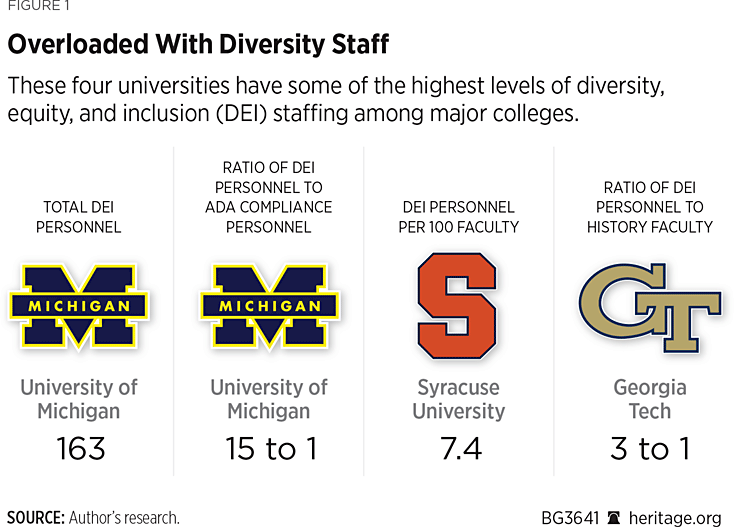
Some universities have small DEI staff. Baylor University and Texas Christian University each list only seven DEI personnel. Mississippi State University has 12. Auburn University and West Virginia University each has 20 DEI personnel, while the University of Arkansas has 21. The University of Miami and University of South Carolina list 23 DEI personnel. There are two dozen DEI staff at Wake Forest University; the University of Mississippi has 25. For a complete set of DEI staff counts ranked from largest to smallest, see Table 1.
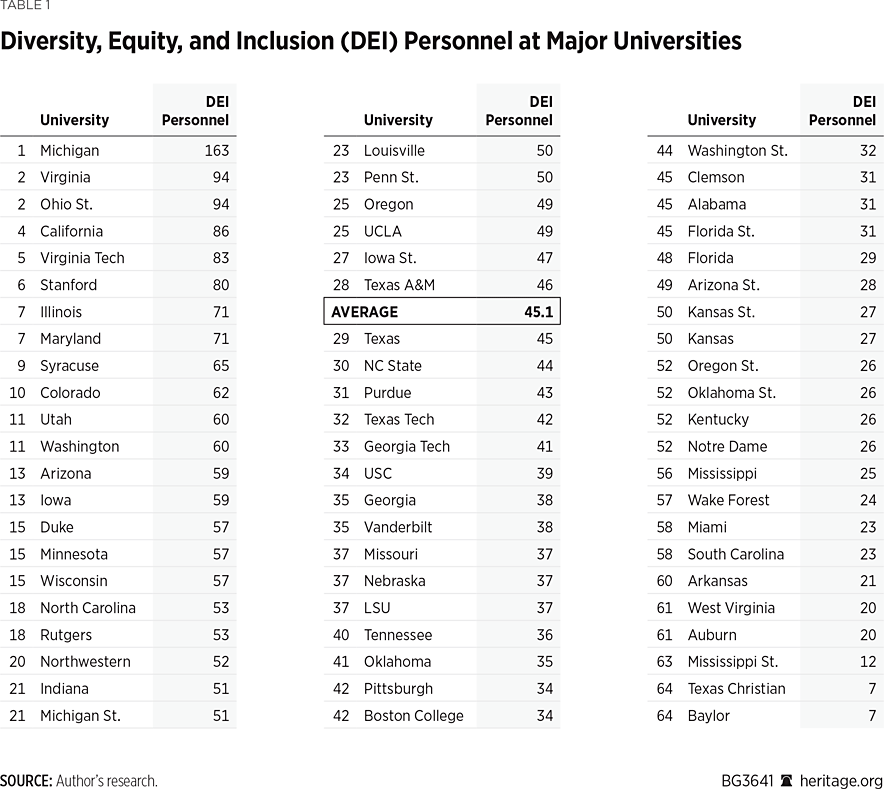
DEI Personnel Relative to Disability Services Staff. It may be difficult to gauge the magnitude of DEI personnel by simply looking at raw counts. To put these figures in perspective, information was also collected on the number of people listed on university websites with responsibility for providing services to people with disabilities.
Universities are required by law to provide reasonable accommodations under the Americans with Disabilities Act (ADA) and other legislation, so the number of ADA compliance staff can be understood as universities fulfilling something they are required to do. In contrast, the number of people universities devote to promoting DEI goals is something they want to do. (Recall that data exclude Title IX and other legal compliance personnel from DEI counts. The ratio of how many people are tasked to DEI relative to ADA goals is therefore illuminating with respect to the energy universities wish to devote to DEI.)
The average university examined has 4.2 DEI personnel for every one ADA compliance person. From the data:
- The University of Michigan lists 14.8 people tasked to promoting DEI for every one person responsible for providing services to students with disabilities.
- The University of North Carolina at Chapel Hill has the second-highest ratio of DEI to ADA personnel at 13.3.
- That ratio at the University of Virginia is 10.4, while at the University of Louisville it is 10.0.
- Boston College lists 8.5 people devoted to promoting DEI for each ADA compliance staffer.
- At the University of Iowa, the ratio is 8.4.
At the other end of the spectrum, Baylor University and the University of Minnesota were the only schools to list more ADA compliance personnel than DEI personnel. For a complete set of DEI/ADA results, see Table 2.
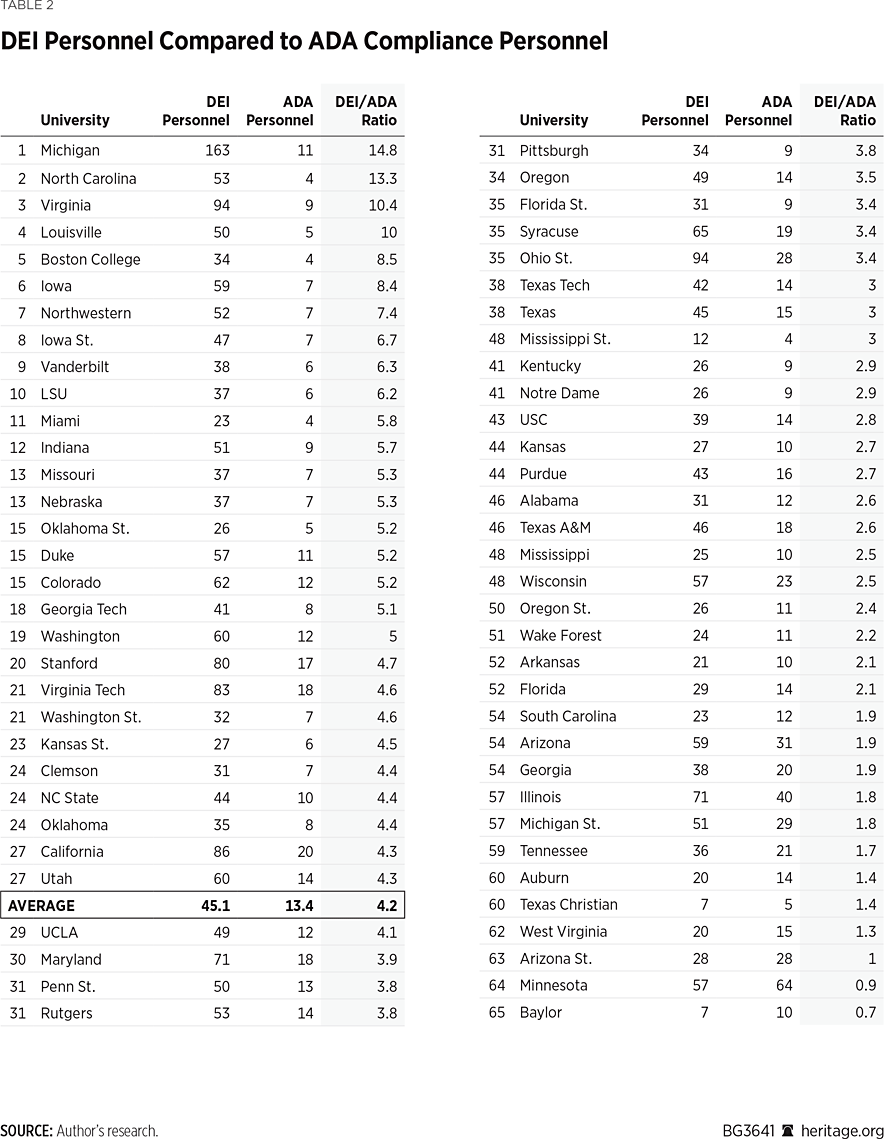
DEI Personnel Relative to Tenured or Tenure-Track Faculty. Another way these authors evaluated the magnitude of DEI staffing is by comparing DEI staff levels to the number of tenured or tenure-track faculty at each university. Those with tenure (or eligible to receive tenure) are core faculty with responsibility to conduct research and teach a broad spectrum of subjects deemed appropriate and necessary. DEI personnel, on the other hand, are likely there to convey a narrower, ideologically motivated range of content and values. DEI staffing relative to tenured faculty may signal how a university prioritizes adherence to DEI relative to the broader, more traditional aims of higher education.
The average university has 3.4 DEI personnel for every 100 tenured or tenure-track faculty. Some institutions have a much higher ratio.
- Syracuse University: 7.4 people devoted to promoting DEI for every 100 core professors to teach and research all academic subjects.
- University of Virginia: 6.5.
- University of Oregon: 6.2.
- University of California at Berkeley: 6.1.
- University of Michigan: 5.8.
- Virginia Tech: 5.6.
For a complete set of DEI personnel per 100 core faculty, see Table 3.
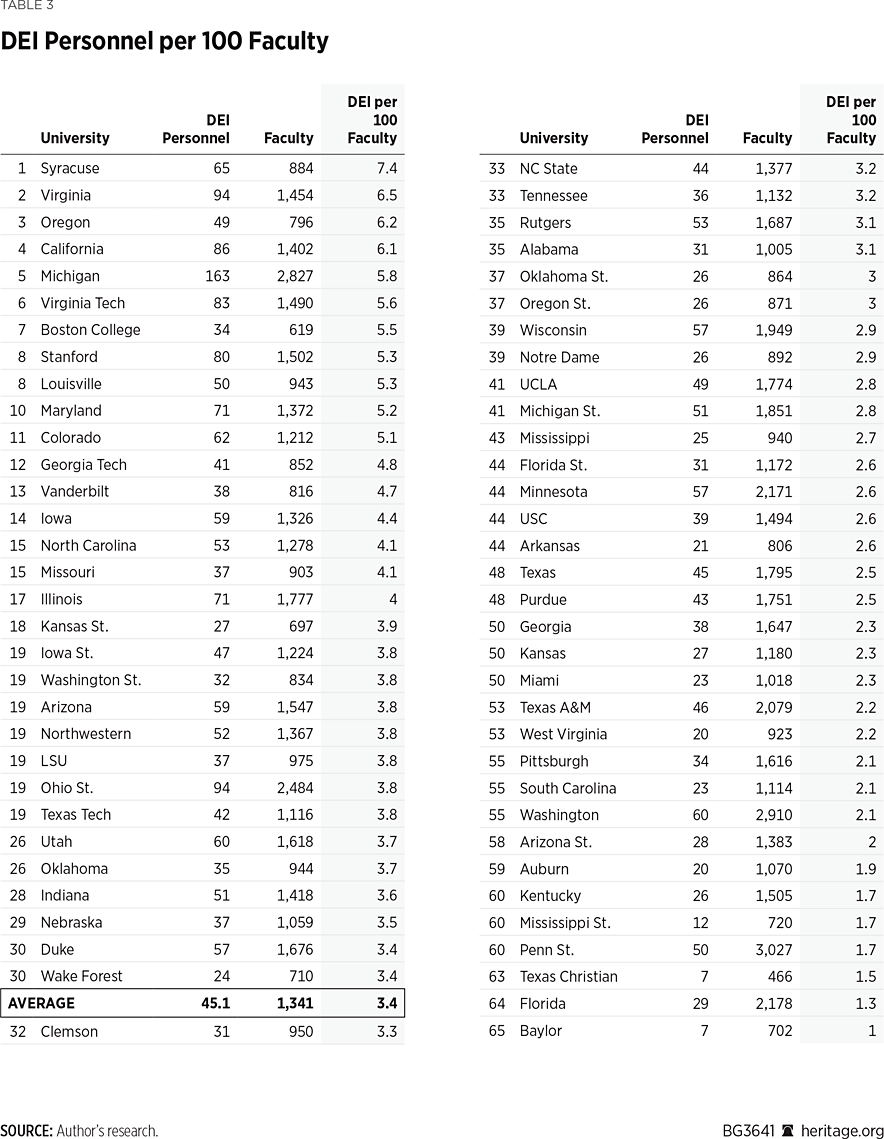
DEI Personnel Relative to History Faculty. These authors also compared each university’s DEI infrastructure to its number of history professors. History is a core academic subject that helps students understand their place in the world, as well as how to put current events in appropriate context and understand how citizens should engage in civic life. The ratio of DEI personnel to history faculty is an indicator of how much universities prioritize the narrower, particular narratives of DEI relative to the broader narratives traditionally covered by history faculty.
The average institution examined lists 1.4 times as many DEI personnel as tenured or tenure-track history professors.
- Georgia Tech: 3.2 people promoting DEI goals for every history professor.
- University of Louisville: 2.9.
- Syracuse University, Virginia Tech, the University of Utah, the University of Michigan, the University of Arizona, Iowa State University, and the University of Iowa all have more than twice as many DEI personnel as history faculty.
Some universities do devote more people to teaching and studying history than to promoting DEI goals. For example:
- Baylor University: three times as many history professors as DEI staff.
- Mississippi State University and Texas Christian University: at least twice as many history professors listed relative to DEI personnel.
- Rutgers University, the University of California Los Angeles, the University of Florida, the University of Texas at Austin, the University of South Carolina, the University of Kentucky, the University of Mississippi, Vanderbilt University, Auburn University, and Notre Dame University all list more history professors than DEI staff.
For a complete set of results on the ratio of DEI personnel to history faculty, see Table 4.
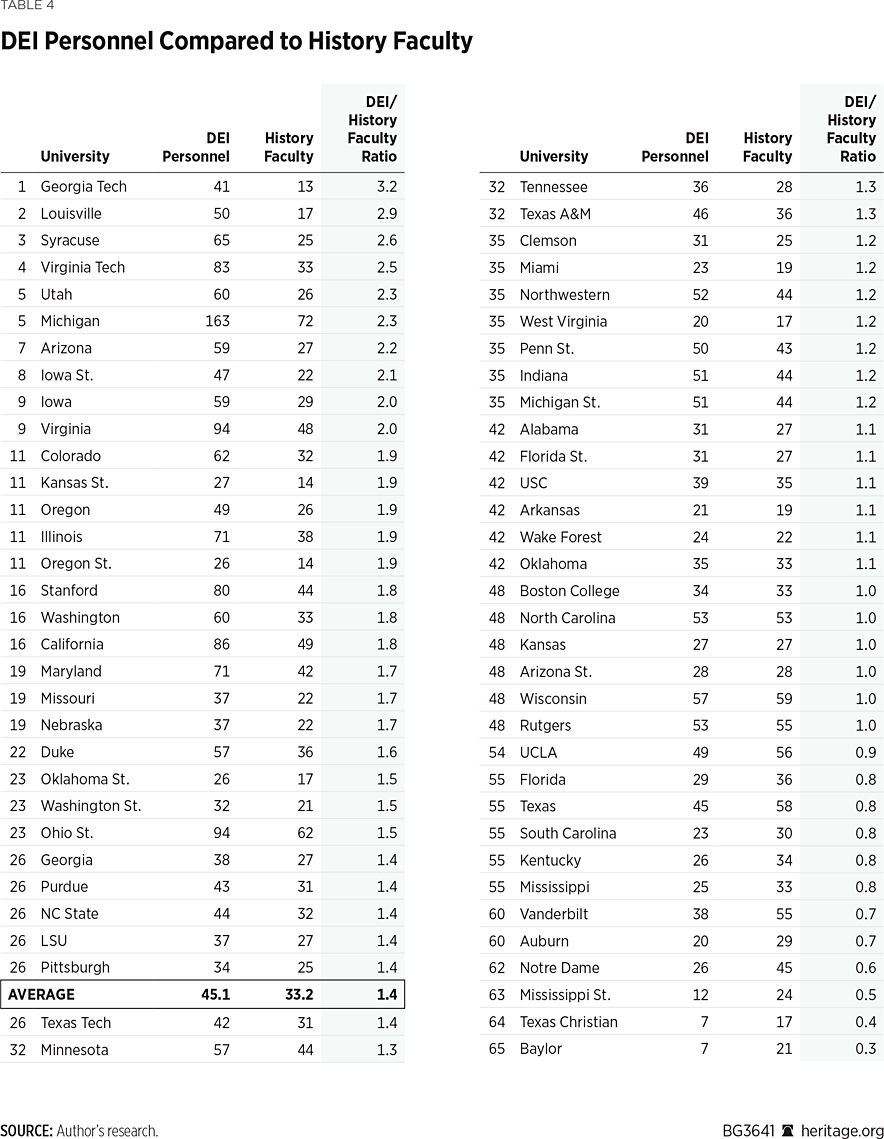
Relationship Between DEI Staff and Diversity Climate. One of the central purposes of DEI efforts is to create a more positive and welcoming environment for students. Many universities that were examined administered surveys to students to collect information on their perceptions of campus climate.
If larger DEI staff numbers are beneficial in achieving the goals of a positive, welcoming environment, one should see more positive responses at the universities with more DEI personnel. In general, however, this is not what was observed. While these authors are constrained in making these comparisons by the fact that universities do not ask identical survey questions at the same time and in the same way, there appears to be little relationship between DEI staffing and the diversity climate on campus.
For example, the University of Michigan has the largest DEI staff on multiple measures. It has the most people working on DEI, and it has the highest ratio of DEI personnel to ADA compliance staff. In a recent climate survey, 72 percent of University of Michigan students report being satisfied or very satisfied with the campus climate.REF Among under-represented minority students, that figure drops to 62 percent for undergraduate students, and 55 percent for graduate students.
These climate outcomes are not much different from Mississippi State University—an institution with far less DEI infrastructure. In a recent survey administered by Mississippi State, students were asked whether they felt “accepted, respected, and appreciated,” which is arguably a tougher bar to meet than simply being satisfied with the climate.REF Despite having a higher standard and significantly smaller DEI staff, 72 percent of Mississippi State students report being accepted, respected, and appreciated by students different from them. Among African American students, 68 percent reported being accepted, respected, and appreciated by students different from them—scarcely different than the overall result. Among Hispanic students the figure is 78 percent—higher than the overall Mississippi State result.
The lack of relationship between DEI staff and climate is also evident when comparing other schools. The University of North Carolina at Chapel Hill has a large DEI emphasis, with the second-highest ratio of DEI personnel to ADA compliance staff among the institutions sampled. In a campus climate survey, UNC students were asked whether they agreed that they “felt a sense of belonging to this campus.”REF Overall, 73 percent agreed with this statement, but among African American students the figure drops to 54 percent. Again, having many people with job responsibilities to promote DEI does not seem to close the gap between African American and other students in terms of their feeling of belonging on campus.
The diversity climate at Baylor University, which has the smallest diversity staff on multiple measures, is more favorable than at North Carolina.REF At Baylor, 76 percent of undergraduate students describe the campus climate as good or very good. That figure drops, but only slightly, to 69 percent among minority students. In general, student reports on campus climate are no better—and often worse, especially for minority students—at universities with larger DEI staff levels.
Discussion
Universities—especially those that are publicly funded—should be welcoming to all students, and it is admirable that inclusion is a priority for so many institutions of higher education. Having said that, this research suggests that large DEI bureaucracies appear to make little positive contribution to campus climate. Rather than being an effective tool for welcoming students from different backgrounds, DEI personnel may be better understood as a signal of adherence to ideological, political, and activist goals.
Administrative Bloat. In addition, high DEI staffing levels suggest that these programs, like many other administrative initiatives at universities, are bloated relative to academic pursuits.REF It is fair to wonder whether reducing administrative bloat and reducing costs would do more to promote college access and inclusion than the best efforts of any diversity officer.
Programming Content. It is also troubling that much of the programming DEI personnel offer tends to lack diversity of viewpoints—and may have the effect of dividing more than including. Further research on the content of this programming and the potentially unintended negative consequences it may have for legitimate diversity and inclusion goals could shed further light on how universities might structure diversity staff more efficiently.
Criteria for Success. This Backgrounder does not advocate for the elimination of DEI programs. Nonetheless, the data suggest that DEI efforts should be proportionate to other goals of higher education and be designed to achieve legitimate goals. Perhaps there should be stated criteria by which success of these programs, offices, and personnel can be measured.
DEI’s Public Funding. Without evidence that DEI initiatives are meeting goals that are broadly supported by the legislators, donors, and tuition-payers who fund universities, it is unclear why these stakeholders should indulge narrowly focused ideological and divisive efforts favored by the people who run universities and a small number of activist students. Given how cash-strapped many of these states are, legislators should consider reducing and restructuring DEI staffs to achieve legitimate goals at substantially lower cost.
Policy Recommendations
In light of the data, university stakeholders at all levels should take the following actions.
- State legislatures, boards of higher education, and university trustees should investigate the extent of resources devoted to DEI personnel at the universities they oversee and subsidize.
- Stakeholders should demand evidence about whether DEI resources are necessary and effective for achieving appropriate goals.
- Those same stakeholders should insist that the content of programs and services offered by DEI staff actually include a diversity of perspectives—and be designed to be inclusive of all students.
Conclusion
Continuing to hire more people with sophisticated, corporate-sounding titles seems unlikely to help students feel welcome and learn from each other—nor will creating new units with more administrators advancing political agendas that may be at odds with the preferences of those who pay and subsidize tuition. Such approaches have more to do with the increasingly imbalanced ideological nature of universities than with actual promotion of diversity, equity, and inclusion.
Jay P. Greene, PhD, is Senior Research Fellow in the Center for Education Policy, of the Institute for Family, Community, and Opportunity, at The Heritage Foundation, and James D. Paul is Distinguished Doctoral Fellow at the University of Arkansas’ Department of Education Reform.
